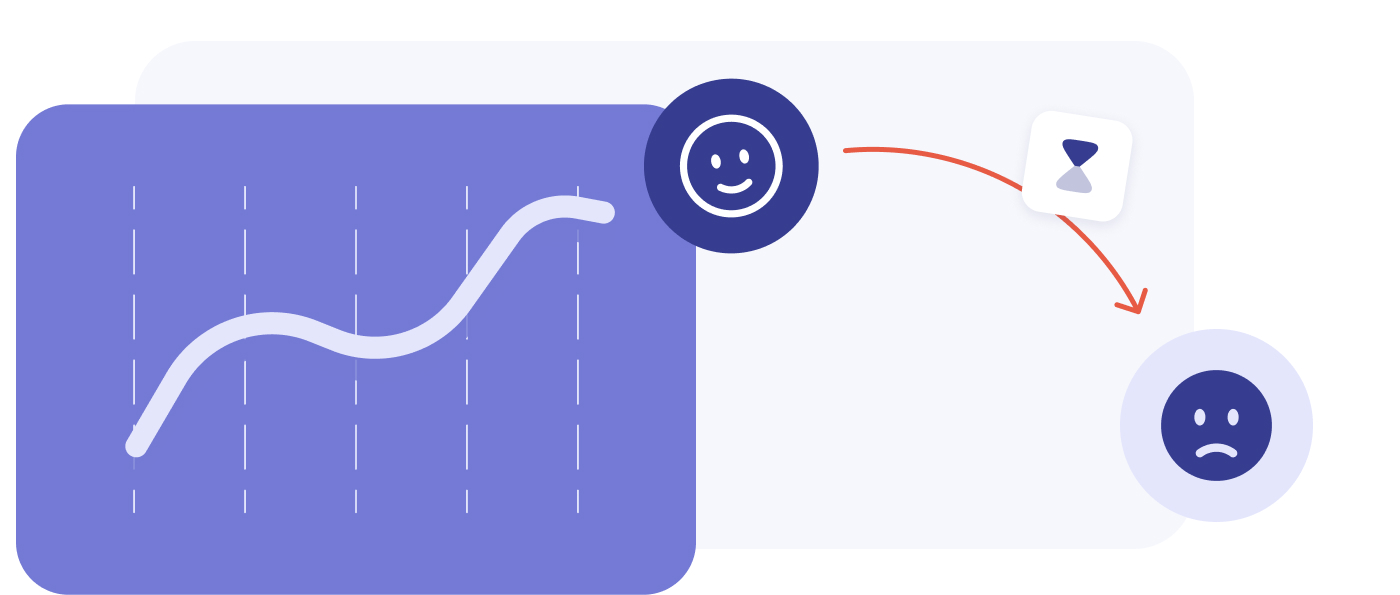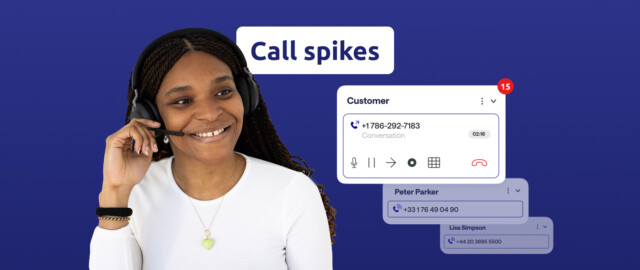What causes call spikes?
Seasonal spikes: predictable, yet often underestimated
In many industries, call center call spikes are seasonal or cyclical. These call surges are relatively easy to predict. A typical example is Black Friday, which heavily impacts e-commerce platforms and marketplaces.
Businesses need to plan ahead for these periods of high call volume. Without proper preparation, they risk being overwhelmed by a flood of inbound calls.
However, planning often falls short. A lack of resources, outdated call routing, or inefficient tools can leave teams struggling. The result? Overloaded agents and deteriorating customer experience.
Unexpected and unpredictable surges: harder to manage
Unlike seasonal spikes, some call surges happen suddenly, with no warning signs. These unpredictable spikes are often triggered by unexpected events, like technical issues, mobile app bugs, delivery delays, viral marketing campaigns, or even a PR crisis on social media.
These surges are particularly challenging because there’s no time to prepare. Without real-time response systems in place, calls pile up within minutes, wait queues grow longer, and agents become overwhelmed. Service quality declines, customers grow frustrated, and your brand suffers.
In these situations, agility is key. Only a flexible, scalable infrastructure can limit the negative effects of unexpected call center call spikes. That’s where smart tools, dynamic routing, and instant scalability come into play.
The impact of poorly managed call spikes

When a contact center faces a flood of calls without proper preparation, the fallout can be widespread, affecting customers, agents, and the company alike.
Longer wait times and frustrated customers
One of the first signs of a call spike is increased wait time. This directly affects the customer experience and can have long-term repercussions.
Excessive waiting leads to frustration and dissatisfaction, often expressed through negative reviews or poor customer ratings.
Decline in service quality
When agents are overwhelmed, they rush through interactions to handle as many calls as possible. This quantity-over-quality mindset reduces active listening, increases mistakes, and leads to impersonal service.
Poorly resolved issues can result in repeat calls, or worse, formal complaints. In the end, poor management of high call volume drags down critical KPIs like First Contact Resolution (FCR).
Higher stress among agents
Agents on the front line bear the brunt of call surges. Intense workloads, frustrated callers, and never-ending queues create constant pressure.
This stress can lead to burnout and disengagement. Over time, that translates into higher turnover, lower morale, and less consistent service delivery. Ultimately, this weakens your contact center’s performance.
It’s essential to provide agents with the right tools, supportive working conditions, and task automation options to help them thrive.
Overflow that impacts every channel
Call spikes don’t stay confined to voice channels. When customers can’t reach you by phone, they naturally switch to other channels: emails, online forms, SMS, social media, or messaging apps like WhatsApp.
The result? Every touchpoint gets overwhelmed, leading to a fragmented, frustrating experience for the customer.
Without proper coordination across channels, inquiries may be handled multiple times, or missed entirely. An email response might be ignored by the agent answering a chat or a call, simply because the information isn’t centralized.
With more and more customer touchpoints, businesses need more than voice optimization. They need a unified omnichannel solution that centralizes interactions, prioritizes based on urgency, and ensures a seamless customer journey across every channel.
How digital solutions can help you manage call spikes

When call volume suddenly surges, speed alone isn’t enough. To ensure service continuity and preserve customer satisfaction, businesses need a strategic mix of anticipation, flexibility, omnichannel management, and automation.
Here are the key pillars of an effective plan for navigating call spikes, without compromising quality or efficiency.
Use data to anticipate call spikes
Call spikes are part of the job in any contact center. The key is adapting your operations to absorb these waves efficiently.
This starts with reliable, actionable data. A solution that offers real-time and historical analytics helps you identify inefficiencies and replicate best practices. KPIs like First Contact Resolution, wait time, and callback rates can highlight both strong and weak areas.
Adjust resources and call flows in real time
Even with good forecasting, some call surges come out of nowhere. That’s why you need a flexible infrastructure that can pivot instantly.
This means adjusting configurations on the fly, such as:
- Inbound campaign scenarios
- ACD (Automatic Call Distribution) settings
- IVR (Interactive Voice Response) flows
Your teams should be equipped with a real-time action plan, and ideally, the ability to scale up quickly by adding more agents when demand rises.
Rethink channel management with an omnichannel approach
When phone lines are overwhelmed, customers reach out via every other available channel: email, messaging apps, social media, SMS. If each is handled separately, chaos follows.
The goal isn’t just to absorb high call volumes, but to offer a consistent, smooth experience across all channels.
An omnichannel platform centralizes interactions, synchronizes agent responses, and keeps track of customer history, regardless of how or where the contact started.
Use automation to lighten the load
Automation helps teams stay focused and avoid burnout. By handling a portion of routine interactions, automation reduces pressure on agents.
Auto-replies for FAQs, smart virtual agents to route requests, or proactive messages to manage wait times can all play a role in reducing call center congestion.
When properly implemented, automation acts as a first line of response—remaining reactive and efficient by relieving agents, improving workflows, and strengthening the overall customer experience during call spikes.
How Diabolocom helps businesses handle call spikes
Built for the operational demands of modern contact centers, Diabolocom’s platform includes all the features needed to manage call spikes smoothly:
- Real-time supervision
- Dynamic call routing
- Intelligent workflows
- Unified omnichannel interface
Cloud-based and highly flexible, the Diabolocom solution lets companies instantly open new channels, onboard remote agents, and adjust routing logic on the fly, with no technical downtime.
This flexibility empowers organizations to maintain both service continuity and quality, even in the face of intense high call volumes.
Conclusion
Call spikes are inevitable in today’s contact centers. Sometimes you see them coming. Sometimes they hit without warning. But it’s not the spike itself that determines your success, it’s how you respond.
Some organizations falter under pressure: teams burn out, customers grow impatient, and service quality crumbles.
Others stay strong. They rely on clear processes, smart tools, and a solid understanding of what’s happening on the ground. Automation, AI, real-time control. These are the levers that give them the agility to act fast and protect what matters most: service quality.
Turning a moment of stress into an opportunity is no longer out of reach. With Diabolocom’s AI-powered CCaaS solution, businesses gain access to all the tools they need to handle call surges with confidence.
Handle call spikes better with Diabolocom



